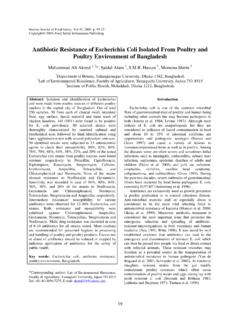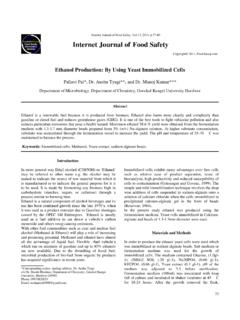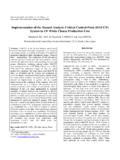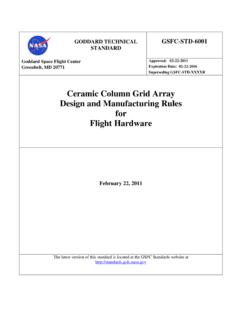Transcription of Microorganisms in Kitchen Sponges
1 Internet Journal of Food Safety :17-22 Microorganisms IN Kitchen Sponges zlem ERDO RUL1*, Feryal ERB L R2 1 Department of Food Engineering, Faculty of Agriculture, 2 Department of Biology, Faculty of Science and Arts; University of Kahramanmara S t mam, 46100 Kahramanmara , Turkey * Corressponding author: ABSTRACT In this study presence of various kinds of Microorganisms in Kitchen Sponges were studied. Additionally effects of regular dish washing liquid on Escherichia coli ATCC 8739 and Salmonella typhimurium ATCC 13311 were investigated under laboratory conditions in Kitchen Sponges with or without food residue. The Sponges involved in daily use in households were samples were analysed for the presence of total mesophilic aerobic bacteria, staphylococci, Pseudomonas, Salmonella, E.
2 Coli and yeast and moulds. Daily application of the dishwashing liquid to the Sponges had no effect on the numbers of yeast and molds, pseudomonads, E. coli. But the number of Salmonella spp. had decreased. S. aureus was not investigated from the house hold Sponges during 10 days. Pseudomonads were the dominant microflora in the Sponges during 10 days. In six households, the regular dish washing liquid were applied for 2 weeks, and it was shown that neither dishwashing liquid reduced total mesophilic aerobic counts, E. coli, pseudomonads or yeast and moulds, except Salmonella spp., however S. aureus declined quickly and was not survived.
3 In addition, in this study the rates of pathogens from artificially contaminated Sponges were investigated. The test organism S. typhimurium decreased below the detection limit within 24 h. With the amount of dishwashing liquid added to the Sponges (3% ), E. coli decreased during 24 h either with or without commercial sterilized milk (10%). In the presence of milk suspension E. coli survived better within two days in the Sponges . The test organism E. coli decreased below the detection limit after day of 2 in the presence of milk. E. coli decreased below the detection limit after day of 1 without milk. The results of this study showed that the regular dish washing liquid was effective in reducing Microorganisms in the laboratory test but not in the used Kitchen Sponges KEY WORDS: Kitchen sponge, survival, regular dishwashing liquid.
4 _____ INTRODUCTION It s known that during the cleaning process of equipment, utensils, sinks, etc. in kitchens, the pre-washing and washing steps are done with the use of Sponges to eliminate food residues. As a consequence of this procedure, part of the food residues adheres to the sponge surfaces. These food residues together with the moisture retained in the Sponges offer a favorable environment for bacterial growth. Early studies on bacterial contamination in the Kitchen were conducted in the late 1960s investigating bacterial load of hand towels and the hygienic conditions of domestic dishcloths and tea towels.
5 Such cloths were heavily contaminated with bacteria and suspected as one of the main vectors for spreading and dissemination of the bacteria in the Kitchen (Speirs et al., 1995). The current attention on bacterial contamination in the Kitchen was started in the late 1970s. Previous studies have suggested that although raw material is probably the main source of contamination in the Kitchen , the area surrounding the Kitchen could also act as sources of free living populations of bacteria. Sponges and dishcloths have been recognized as potential agents in the spread of Microorganisms , and it has been observed that bacteria persist in these vehicles (Josephson et al.)
6 , 1997; Scott and Bloomfield, 1990; Speirs et al., 1995). Several studies indicated that various bacteria, including Escherichia coli, Staphylococcus aureus and Salmonella spp., survive on hands, Sponges /cloths, utensils and currency for hours or days after initial contact with the Microorganisms (Jiang and Doyle, 1999; Kusumaningrum et al., 2002). Detergents and dish washing liquids are antibacterial products and specifically manufactured for the reduction of bacteria in Sponges and cleaning cloths. A lot of antibacterial products, promoted by producers, are specifically manufactured for the reduction of bacteria in cleaning cloths and Sponges .
7 Outbreaks of food poisoning frequently occur as a result of improper food preparation in which cross-contamination in combination within adequate storage or cooking was implicated in many instances (Olsen et al., 2000) Dishcloths and Sponges were recognized as a potential source for spreading Microorganisms and it was observed that bacteria persisted in these vehicles (Josephson et al., 1997; Rusin et al., 1998). Enteric pathogens, such as E. coli, Klebsiella pneumoniae, and Enterobacter cloacae were isolated, as well as other types of pathogens 17(S. aureus) and opportunistic pathogens (Pseudomonas spp.)
8 A lot of antibacterial products, promoted by producers, are specifically manufactured for the reduction of bacteria in cleaning cloths and Sponges . These include bleach solutions, detergent, and dishwashing liquid. Limited studies have addressed the e9ectiveness of these products to inactivate Microorganisms on Sponges . Kusumaningrum et al. (2002) studied the effect of an antibacterial dishwashing liquid on E. coli, Salmonella Enteritidis, S. aureus and Bacillus cereus in a modified suspension test and in used Sponges with and without food residues under laboratory conditions. There were two objective of this study.
9 One of it was to evaluate, with respect to microbial status, Sponges used in 6 house kitchens. The Kitchen Sponges were monitored for: total mesophilic aerobic bacteria, staphylococci, Pseudomonas, Salmonella, E. coli and yeast and moulds. In a second phase, the effects of an antibacterial dishwashing liquid on E. coli and Salmonella typhimurium were investigated in Sponges with or without food residues under laboratory conditions. MATERIALS AND METHODS Sponges and dish washing liquid.
10 Synthetic yellow Sponges with green pads (Balerina, 9:7:3; Turkey) and regular dishwashing liquid were obtained from retail markets. Prior to use, the sponge was washed to remove all trace of preservatives and other chemicals that may have an antibacterial effect with dishwashing liquid in hot water (60-65oC). The sponge was placed into a sterile bag with 100 ml sterile cold tap water, and the bag contents were mixed for 60 s. The sponge was removed from the bag, rinsed thoroughly with cold water and squeezed to remove excess liquid. The sponge was then boiled in sterile distilled water for 10 min, excess water was removed and the sponge was dried overnight in an oven.











